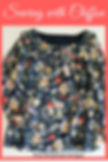9 Tips for Sewing with Chiffon Fabric
- Lisa Hawkes
- Aug 7
- 3 min read
Updated: Aug 26

Updated August '25: A few months ago I had to stop in the fabric shop to pick up a few notions and I spotted this lovely fabric. If you know me, you know that I love navy, flowers and prints, so... even though it was a sheer polyester chiffon, I gave in to temptation and brought this lovely fabric home with me. I did wonder if I should have my head examined. Polyester Chiffon isn't a fabric I would normally choose to sew with, but sometimes we just need to challenge ourselves! I LOVE how my blouse turned out and I manged to create it without ripping out, swearing underneath my breath, or promising myself I would never sew with this fabric again! So here are my tips and tricks to set yourself up for success if you fall for a poly chiffon or other difficult fabric the next time you are fabric shopping!

Tips for Sewing With Chiffon Fabric:
Choose your pattern carefully.
The fabric is difficult to work with, so make sure the pattern is simple. I chose NewLook 6395. No darts, no zippers, no buttonholes. It is loose fitting so I am not trying to fit or shape this fabric in any way. The pattern makes full use of the lovely drape of the fabric.
Use a new Needle.
You don't want to risk snags so make sure the needle is new and use a microtext needle.
Cut the Fabric out with a Rotary Blade.
The fabric shifts around easily, so skip the fabric shears and cut everything out with the rotary cutter. There is no need for a ruler, the fabric cuts easily so just glide it around the pinned pattern.
Use lots of Pins & possibly Tissue Paper
Use lots of pins and skip the fabric weights. As I said above the fabric shifts easily so make sure it can't move. Pinning the fabric to tissue paper can also give added stability.
Transfer any markings before you move the fabric because of #3 and #4 above.
Cut a piece and then transfer all markings before cutting the next piece.
Use an underlining if possible to provide added stability and hide the seam allowances.
An underlining is when the two pieces of fabric are stitched together in the seam allowances and then treated as one. I underlined the yoke pieces because two layers of this fabric are easier to work with than one. An underlining also hides the seam allowances where a lining would possibly allow the seam allowances to show through the sheer chiffon. The sleeves are a single layer of just the chiffon, but the rest of the blouse has 2 layers. I also finished the neckline using the pattern facings. I could have treated the second layer as a lining and used it to finish the neckline thus eliminating the facings, but using an underlining and a facing gave me a lot of control over the neckline.
Use French Seams or the Rolled Edge setting on a Serger when sewing just the chiffon to provide a neat finish in case it shows through the chiffon.
This also takes care of the tendency of this fabric to ravel excessively. I used french seams for the side seams of the blouse and sleeves. The solid navy that provides the second layer is finished separately at the side seams and the hem.
Serge seams that aren't sewn with French seams.
I stitched all seams first with my sewing machine and then went back and serged them together, again because multiple layers of this fabric are easier to control than a single layer. I also wanted to be able to check everything before serging. I doubted that this fabric would handle ripping out well. The armholes and yoke seams are all serged.
Hem the layers separately so each falls neatly.
I hemmed the navy layer with a 1 inch hem and the print layer with a 1/2" hem so the navy layer is just a little shorter.
One tip that I found often online that didn't help at all was using spray starch. It made no difference to my fabric but that might not be the case for your fabric or with different types of starch. I can't wait to wear my new blouse!
